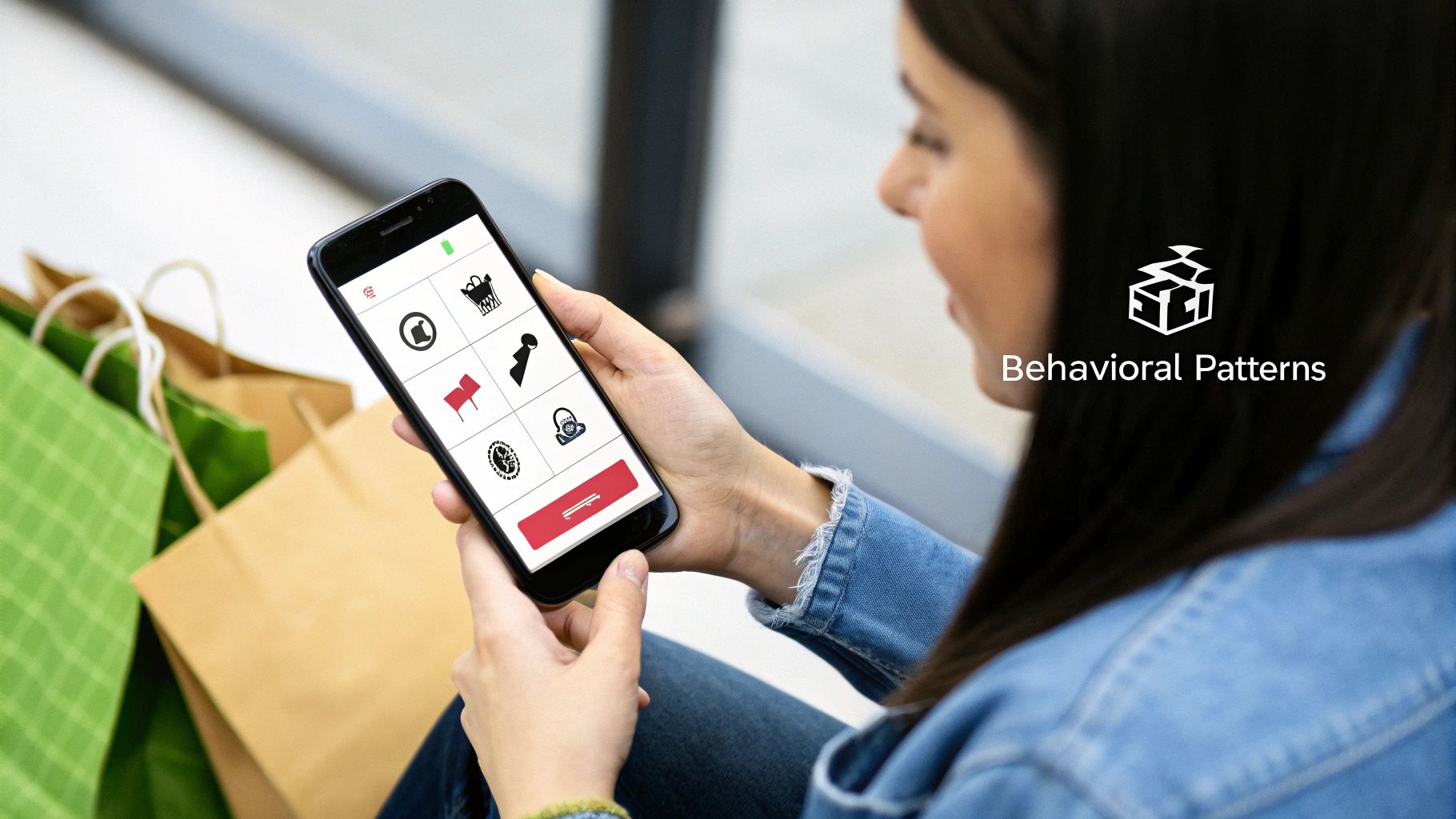In a world saturated with marketing messages, treating your entire audience as a single, monolithic group is a recipe for failure. Generic, one-size-fits-all campaigns get ignored because they don't speak to anyone's specific needs, challenges, or motivations. This is where a deliberate approach to customer segmentation strategies becomes a powerful engine for growth, transforming your marketing from a wide-net shout into a series of meaningful conversations. By dividing your broad customer base into smaller, more manageable groups based on shared characteristics, you can tailor your messaging, product features, and overall experience with precision.
This shift allows you to create highly relevant campaigns that resonate deeply, boost engagement, and ultimately drive higher conversion rates and customer loyalty. Before implementing any strategy, a robust foundation in understanding your audience is essential, as detailed in this comprehensive B2B customer research guide.
This article cuts through the theory to provide a practical, actionable roundup of the most effective customer segmentation strategies you can implement today. We will explore nine distinct models, moving beyond the basics to give you the specific details and examples needed to apply them to your own business. You will learn how to:
- Identify the right segmentation models for your company.
- Gather the necessary data for each strategy.
- Translate those segments into targeted, high-impact marketing actions.
1. Demographic Segmentation: The Foundational Layer
Demographic segmentation is one of the most straightforward and widely used customer segmentation strategies. It involves dividing your market into smaller categories based on quantifiable personal characteristics. Think of it as the essential "who" in understanding your customer base. This method provides a clear, data-driven snapshot of your audience, making it a crucial starting point for any targeted marketing effort.
These segments are based on objective, factual data points, which are often easy to collect through signup forms, surveys, or public data sources. By understanding these core attributes, you can create broad but effective campaigns that resonate with specific groups' needs and life stages.
Key Demographic Variables
- Age: Different age groups have distinct preferences, media consumption habits, and purchasing power.
- Gender: Certain products or marketing messages may appeal more strongly to one gender over another.
- Income: This directly impacts affordability and willingness to spend on premium versus budget-friendly products.
- Occupation: A customer's profession can influence their needs, daily challenges, and the tools they require.
- Education Level: This can correlate with communication preferences, technical aptitude, and income.
Actionable Implementation Example
A project management SaaS company can use demographic data to refine its messaging. For a user segment of 22-28 year old junior developers, they might highlight features for collaboration and learning. For a segment of 45-55 year old project managers in enterprise roles, they would instead emphasize features related to budget tracking, team oversight, and advanced reporting. This simple demographic split allows for more relevant and effective communication without complex behavioral analysis, making it a powerful foundational strategy.
2. Geographic Segmentation: Adapting to Local Context
Geographic segmentation involves dividing your audience based on their physical location. This strategy operates on the principle that a customer's needs, preferences, and purchasing habits are often influenced by where they live, work, and shop. It extends beyond just country or state, drilling down into specific regions, cities, climates, or even neighborhood types like urban, suburban, or rural.
This method is critical because local culture, weather, and economic conditions directly impact consumer behavior. By tailoring your products, services, and marketing messages to these local nuances, you can create a much more relevant and resonant customer experience. It’s one of the most effective customer segmentation strategies for businesses with a physical presence or those shipping products to diverse areas.
Key Geographic Variables
- Location: Country, state, city, or even a specific zip code.
- Climate: Hot versus cold, or seasonal variations that influence purchasing cycles.
- Culture: Regional traditions, languages, and lifestyle preferences that affect product appeal.
- Population Density: Differentiating between urban and rural markets, which often have different needs and access to services.
- Economic Conditions: Local income levels, cost of living, and economic health that can dictate pricing strategies.
Actionable Implementation Example
A home improvement retail chain like The Home Depot uses geographic segmentation to optimize its inventory. Stores in Florida and Arizona will stock a wide array of pool supplies, drought-resistant plants, and high-efficiency air conditioning units year-round. In contrast, stores in Vermont and Minnesota will prioritize snow blowers, heavy-duty insulation, and ice melt, especially in the fall and winter months. This location-based approach ensures product offerings directly address the immediate, practical needs of local customers, driving sales and reducing irrelevant stock.
3. Psychographic Segmentation: Understanding the 'Why'
Psychographic segmentation moves beyond the "who" (demographics) to explore the "why" behind consumer behavior. It involves grouping customers based on their psychological attributes, such as personality traits, values, interests, lifestyles, and opinions. This method is one of the most powerful customer segmentation strategies for building deep, emotional connections with your audience.

By understanding what truly motivates your customers, you can craft marketing messages that resonate on a personal level. This approach allows you to align your brand's story with the core values and aspirations of your target segments, fostering loyalty that transcends product features or price points.
Key Psychographic Variables
- Lifestyle: How people spend their time and money, such as being an urban professional, a digital nomad, or a suburban parent.
- Values & Beliefs: Core principles that guide decisions, like environmental consciousness, family focus, or a commitment to social justice.
- Interests & Hobbies: Activities customers are passionate about, from hiking and gaming to cooking and coding.
- Attitudes & Opinions: A person’s preconceived notions or feelings towards specific topics, brands, or industries.
- Personality Traits: Inherent characteristics like being an introvert, an innovator, an adventurer, or a pragmatist.
Actionable Implementation Example
A membership platform for creative professionals can use psychographic data to tailor its entire user experience. For a segment of "Aspiring Innovators" who value cutting-edge tools and self-expression, the platform might feature case studies of groundbreaking projects and market its API for custom integrations. For a segment of "Pragmatic Freelancers" who value stability and efficiency, it would highlight features like secure invoicing, project templates, and reliable client management tools. This deep understanding of user motivations allows the platform to speak directly to what each user segment truly cares about, creating a much stickier product.
4. Behavioral Segmentation: The Science of Customer Actions
Behavioral segmentation moves beyond who customers are and focuses on what they do. This powerful strategy groups customers based on their direct interactions with your product, website, or marketing campaigns. It analyzes patterns in their purchase history, feature usage, brand loyalty, and overall engagement, providing a dynamic view of customer intent and needs.

Unlike demographic or psychographic data, which can be based on assumptions, behavioral data is concrete evidence of how users derive value from your offering. This makes it one of the most effective customer segmentation strategies for driving personalization, improving retention, and predicting future actions. It answers critical questions like which features are most valued, who your most loyal customers are, and which users are at risk of churning.
Key Behavioral Variables
- Purchase History: Analyzing what, when, and how often customers buy. This includes average order value (AOV) and product category preferences.
- Usage Rate: Segmenting users as heavy, medium, or light users of your product or service.
- Benefits Sought: Grouping customers based on the specific value or solution they are looking for, such as convenience, cost-savings, or advanced features.
- Customer Loyalty: Identifying loyal advocates versus one-time buyers or at-risk customers.
- Engagement Level: Tracking interactions with marketing materials like email open rates, click-through rates, and app session frequency.
Actionable Implementation Example
A streaming service like Netflix uses behavioral segmentation to create a hyper-personalized experience. A user who frequently watches action movies and historical documentaries will see their homepage populated with similar content recommendations. In contrast, a user who primarily watches stand-up comedy and romantic comedies receives a completely different set of suggestions. The platform also uses behavior like watch time and content completion rates to segment users for targeted promotions, such as notifying them when a new season of a favorite show is released, thereby increasing engagement and reducing churn.
5. Firmographic Segmentation: The B2B Blueprint
Firmographic segmentation is the essential B2B equivalent of demographic segmentation. It involves categorizing business customers based on specific company attributes, providing a clear framework for understanding and targeting organizations. This method answers the fundamental "who" and "what" of your business customer base, allowing you to tailor strategies to an organization's specific operational context.
These segments are built on objective, verifiable data points about companies, which can be gathered from business directories like Dun & Bradstreet, professional networks like LinkedIn, or directly through lead generation forms. By understanding these core firmographic traits, B2B companies can create highly relevant sales and marketing campaigns that speak directly to a company's unique challenges and scale.
Key Firmographic Variables
- Industry: A company's industry (e.g., healthcare, finance, manufacturing) dictates its specific needs, regulatory challenges, and buying cycles.
- Company Size: This can be measured by the number of employees or annual revenue and directly influences purchasing power and solution complexity.
- Location: Geographic location can impact business needs due to local regulations, market conditions, or cultural factors.
- Stage/Structure: A startup's needs differ vastly from a mature, publicly-traded enterprise.
- Technology Stack: The existing software and technology a company uses can indicate its readiness for new solutions.
Actionable Implementation Example
A cloud infrastructure provider can use firmographic data to create distinct value propositions. For a segment of startups in the fintech industry with fewer than 50 employees, they might highlight scalable, cost-effective solutions and quick deployment. For a segment of large, established retail enterprises with over 10,000 employees, they would instead emphasize robust security, compliance certifications like PCI DSS, and dedicated enterprise support. This firmographic approach is a cornerstone of effective B2B customer segmentation strategies, ensuring messaging and product offerings align perfectly with the target organization's profile.
6. Technographic Segmentation: Targeting the Tech Stack
Technographic segmentation groups customers based on the technology they use, from hardware and software to platforms and applications. In a digital-first economy, understanding a customer’s tech stack is no longer just for B2B SaaS companies; it provides critical context about their habits, preferences, and operational sophistication. It answers the crucial question: "What tools empower your customers?"
This strategy moves beyond simple demographics or behaviors to analyze the technological ecosystem your audience lives in. This data can be gathered through website analytics, integrations, surveys, or by analyzing support tickets. By understanding a customer's tech choices, you can tailor product features, marketing messages, and onboarding processes to align with their existing workflows and technical capabilities.
Key Technographic Variables
- Device Usage: Are they primarily on mobile, desktop, or tablet? Do they favor iOS over Android, or Windows over macOS?
- Software Preferences: What specific applications do they use for work or leisure (e.g., Slack, Asana, Adobe Creative Cloud)?
- Social Media Platforms: Which networks do they actively engage with (e.g., LinkedIn for professionals, TikTok for Gen Z)?
- Technology Adoption Rate: Are they early adopters who crave new features, or laggards who prefer stable, simple tools?
Actionable Implementation Example
A B2B marketing automation platform can use technographic data to create highly personalized outreach. They might identify a segment of customers who use Salesforce as their primary CRM. Instead of a generic message, they can target this segment with campaigns highlighting their platform's seamless, one-click Salesforce integration. This approach directly addresses a known part of the customer's workflow, making the value proposition instantly more relevant and compelling. For advanced users, learning about software integration best practices can further enhance their experience.
7. Value-Based Segmentation: Prioritizing Your Most Important Customers
Value-based segmentation shifts the focus from who the customers are to what their economic worth is to your business. This highly strategic approach involves grouping customers based on their financial contribution, allowing you to allocate resources more effectively. Instead of treating all customers equally, you prioritize efforts on those who generate the most revenue, have the highest profitability, or show the greatest potential for future growth.
This method requires a robust understanding of customer financial metrics. It helps businesses move beyond simple transactional views to a more sophisticated, long-term perspective on customer relationships. By identifying your high-value segments, you can design exclusive experiences, dedicated support, and loyalty programs that drive retention and maximize profitability.
Key Value-Based Variables
- Customer Lifetime Value (CLV): The total revenue a business can expect from a single customer account throughout the business relationship.
- Average Revenue Per User (ARPU): A measure of the revenue generated per customer over a specific period.
- Purchase Frequency & Recency: How often and how recently customers make purchases, indicating engagement and loyalty.
- Profitability Margin: The profit generated from a customer after accounting for all associated costs.
- Growth Potential: The likelihood that a customer will increase their spending or upgrade to higher-tier plans over time.
Actionable Implementation Example
A B2B SaaS company can implement value-based segmentation to optimize its customer success efforts. The top 10% of customers, identified by their high CLV and ARPU, are placed in a "VIP" or "Enterprise" tier. This segment receives a dedicated account manager, proactive support, and early access to new features. In contrast, lower-value customers might be served through a self-service knowledge base and automated email campaigns. This tiered approach ensures that high-impact accounts receive premium attention, which is crucial for maximizing SaaS customer retention. You can learn more about how this impacts SaaS customer retention strategies on refgrow.com.
8. Needs-Based Segmentation: Solving the Core Problem
Needs-based segmentation shifts the focus from who the customer is to why they are buying. This powerful strategy groups customers based on the specific problems they are trying to solve or the outcomes they want to achieve. It goes beyond demographics and behaviors to uncover the functional and emotional drivers that influence purchasing decisions, allowing you to position your product as the ideal solution.
This approach, closely related to the "Jobs to be Done" framework, is about understanding the underlying task a customer is "hiring" your product to do. By identifying these core needs, you can create highly resonant messaging and product features that directly address customer pain points, building a much stronger foundation for loyalty and satisfaction.
Key Needs-Based Variables
- Functional Needs: The practical, tangible problems a customer needs to solve (e.g., saving time, organizing data, reducing costs).
- Emotional Needs: The feelings a customer wants to experience (e.g., security, confidence, a sense of belonging, reduced anxiety).
- Social Needs: How a product helps a customer be perceived by others (e.g., appearing innovative, competent, or responsible).
- Desired Outcomes: The specific, measurable results a customer hopes to achieve by using a product or service.
Actionable Implementation Example
A fitness app provider can use needs-based segmentation to serve diverse user goals. One segment might have a "convenience and accountability" need; they are busy professionals who want quick, guided workouts they can do at home. For them, the app would highlight 15-minute HIIT sessions and push notification reminders. Another segment might have a "performance and community" need; they are competitive athletes seeking to track detailed metrics and connect with peers. For this group, the company would emphasize advanced analytics, leaderboards, and integrated social features. This strategy directly aligns the product's value with the customer's core motivation, a key factor in long-term engagement. Understanding these needs is crucial for improving customer loyalty; you can learn more about how to improve client retention at Refgrow.com by focusing on what your users truly require.
9. Occasion-Based Segmentation: Targeting by Timing and Context
Occasion-based segmentation categorizes customers based on specific moments or situations when they are most likely to need, purchase, or use a product. This strategy recognizes that the same customer can exhibit entirely different behaviors and priorities depending on the context, such as a holiday, a life event, or even the time of day. It moves beyond who the customer is to focus on when and why they are buying.
This method is incredibly powerful because it allows businesses to align their marketing messages and product offerings with the immediate needs and motivations of their audience. By understanding these specific usage contexts, you can create highly relevant, timely campaigns that capture customers at their moment of highest intent, making it a key part of any sophisticated set of customer segmentation strategies.
Key Occasion-Based Variables
- Universal Occasions: These are events experienced by large groups, like holidays (e.g., Christmas, Valentine's Day) or seasons (e.g., summer, back-to-school).
- Personal Occasions: These are individual-specific events, such as birthdays, anniversaries, promotions, or vacations.
- Time-of-Day/Week: Certain products see demand spikes at specific times, like coffee in the morning or food delivery services on Friday nights.
- Usage Context: This involves the specific situation in which a product is used, like a business trip versus a family vacation for a hotel booking.
Actionable Implementation Example
A ride-sharing app like Uber or Lyft uses occasion-based segmentation to great effect. For the morning commute occasion, it can promote scheduled rides or offer discounts on shared rides to work. For the weekend nightlife occasion, it might highlight its safety features and partnerships with local bars or event venues. During a major city-wide concert or festival, it can implement dynamic pricing and position drivers in high-demand zones. This contextual targeting ensures the service remains relevant and valuable no matter the user's specific, time-sensitive need.
Customer Segmentation Strategies Comparison
| Segmentation Type | Implementation Complexity 🔄 | Resource Requirements ⚡ | Expected Outcomes 📊 | Ideal Use Cases 💡 | Key Advantages ⭐ |
|---|---|---|---|---|---|
| Demographic Segmentation | Low - simple data collection and analysis | Low - widely available census and survey data | Broad targeting, strong predictive power in many markets | Mass marketing, media planning | Easy to implement and understand; affordable data; reliable for many products |
| Geographic Segmentation | Low to Medium - requires local knowledge | Medium - geographic and cultural research needed | Targeted local marketing, improved distribution | Regional/local campaigns, logistics | Enables tailored messages for regions; efficient resource allocation |
| Psychographic Segmentation | High - complex, subjective data analysis | High - costly surveys and qualitative methods | Deep customer insights, emotional brand connection | Premium/lifestyle products, brand positioning | Captures motivation & attitudes; predicts future behaviors |
| Behavioral Segmentation | High - requires advanced tracking systems | High - extensive data collection & analytics | Highly personalized marketing, predictive accuracy | E-commerce, loyalty programs, digital marketing | Data-driven, closely tied to actual customer actions; improves ROI |
| Firmographic Segmentation | Medium - B2B data gathering and validation | Medium - business info often public but needs analysis | Targeted B2B sales and marketing strategies | B2B companies focusing on industry & size | Relevant to B2B; easy to obtain company data; enables account-based marketing |
| Technographic Segmentation | Medium to High - needs tech usage data | Medium to High - specialized data and analysis tools | Customized tech product offers, UX optimization | Tech products/services, digital marketing | Valuable for digital-first products; predicts tech adoption trends |
| Value-Based Segmentation | High - requires sophisticated analytics | High - detailed customer financial data and modeling | Optimized resource allocation, improved profitability | Customer retention, VIP programs | Directly ties segmentation to business value; maximizes ROI |
| Needs-Based Segmentation | High - deep customer research necessary | High - qualitative and quantitative research | Strong product-market fit, innovation opportunities | Product development; solving customer pain points | Focuses on customer needs; enables differentiation and loyalty |
| Occasion-Based Segmentation | Medium - ongoing data on timing & context | Medium - detailed usage and event data | Highly targeted campaigns, seasonal optimization | Seasonal products, event-driven marketing | Increases message relevance; multiple touchpoints for same customer |
From Strategy to Action: Weaving Segmentation into Your Growth Fabric
Throughout this guide, we've explored a powerful arsenal of customer segmentation strategies, moving from foundational demographic and geographic models to more nuanced approaches like psychographic, technographic, and value-based segmentation. The core lesson is clear: in a competitive market, treating your entire audience as a monolithic entity is a recipe for wasted resources and missed opportunities. True growth is unlocked when you understand the distinct groups within your customer base and tailor your efforts accordingly.
The most effective customer segmentation strategies are not static; they are dynamic, living frameworks that evolve with your business and your market. You might start with simpler firmographic and behavioral data, but as you mature, layering in needs-based or occasion-based insights will provide the competitive edge needed to scale effectively, especially for SaaS and product-led companies.
Key Takeaways and Your Next Moves
The journey from data to profit requires a deliberate, step-by-step approach. Here’s how to translate the concepts we've discussed into tangible business outcomes:
Start with Your Goal: Don't segment for the sake of segmenting. Are you trying to reduce churn, increase upsells, improve onboarding, or acquire a new type of customer? Your objective will determine which segmentation model (or combination of models) is most relevant. For example, a churn reduction goal pairs perfectly with value-based and behavioral segmentation.
Combine and Conquer: The real power emerges when you layer different segmentation models. Combining firmographic data (e.g., company size) with technographic data (e.g., existing software stack) and behavioral insights (e.g., high-frequency feature usage) creates a hyper-specific, actionable segment that is far more valuable than any single model on its own.
Activate Your Segments: Segmentation without action is just an academic exercise. A critical step in acting on your segmentation insights is defining robust buyer personas for your most valuable segments. These personas transform raw data into relatable human stories that your marketing, sales, and product teams can rally behind. Use them to guide everything from ad copy and email campaigns to feature prioritization and customer support protocols.
Mastering these diverse customer segmentation strategies is more than just a marketing tactic; it’s a fundamental business discipline. It allows you to build products people love, create marketing that resonates, and deliver experiences that foster deep, lasting loyalty. By seeing your customers not as a crowd but as a collection of distinct communities with unique needs, you build a resilient, customer-centric engine for sustainable growth. The initial effort invested in gathering data and building segments pays exponential dividends in customer lifetime value and market leadership.
Ready to put these strategies into practice? Refgrow provides the powerful referral and affiliate marketing tools you need to activate your most valuable customer segments. Launch targeted campaigns for specific personas and turn your loyal customers into your most effective growth channel. Discover how Refgrow can amplify your segmentation efforts today.

